| Botanical Name |
Agapanthus Praecox subsp minimus |
| Family |
Amaryllidaceae - Subfamily Agapanthoidea - The agapanthus family. |
| Pronunciation |
ag-uh-PAN-thus PREE-koks subsp. MIN-eh-mus |
| Common Name(s) |
|
| Plant Group |
- Bulb / Corm / Rhizome / Tuber / Epigeal bulb Bulbs: are made up of fleshy scales as in an onion
Corm: a short, swollen, underground stem that is hard and not fleshy as in a gladiolus
Tuber: a solid, fleshy, underground, storage organ as in a potato
Rhizome: an underground, horizontal, swollen stem at the base of the plant as in an iris
Epigeal bulb: bulbs that rest above the ground with only the roots anchoring the plant to the earth as in albuca
|
| Plant Size |
- Small to Medium
| Tree | 8m to 15m |
| Shrub | 75cm to 1m |
| Perennial/ground cover | 20cm to 40cm |
| Bulb | 30cm to 40cm |
| Succulent | 20cm to 40cm |
|
| Position |
- Light or Dappled Shade Found below trees with sparse, open foliage. Ideal for the protection of herbaceous plants.
- Partial Shade The area is in shade for part of the day and in full sun for part of the day.
- Sun The area is in full sun for all or most of the day, all year round.
|
| General Information |
- Drought Tolerance: High The plant is well adapted to arid conditions; it can survive long periods of drought and high temperatures without extra water.
- Evergreen Plants that have leaves all year round.
- Roots Non-invasive Safe to plant near pools, paving, walls or buildings.
- Sand tolerant Plants adapted to survive in nutrient poor, very sandy soils.
- Water Moderate These plants will need some extra watering compared to water-wise plants. Plant them together, in at least some shade and in a convenient proximity to the house so that grey water can be utilised during times of drought.
- Wind Tolerant Plants able to withstand the effect of strong winds.
|
| Specific Information |
Agapanthus praecox subsp. minimus has strap-like, evergreen leaves but is slightly smaller than the subsp. praecox. The plant quickly forms dense clumps of separate plants so often a few flowers will rise from one clump, resulting in an abundance of flowers over a long period. This subspecies does well even in poor soils and thrives and survives periods of drought. The flowers are a slightly paler blue and in my garden they only start flowering about two to three weeks after Agapanthus praecox subsp. praecox, lasting into early autumn.
|
| Ad Break |
|
| Flowers |
| Description |
trumpet-shaped individual flowers in a loose round head on a stem up to 80 cm tall
|
| Season |
- Summer to Autumn Plants will seldom bloom for the entire season as given in the list, but should flower during a period within these parameters.
|
| Colour |
|
| Growth Rate |
- Fast Specifying growth rate can be very misleading as there is considerable variation of growth rate depending on type and species of plant, available water, supplementary feeding, mulching and general care, as well as the plants suitability and adaptability to the garden environment.
|
| Plant Uses |
- Accent or Focal Point A plant used to attract the attention because of its colour or form.
- Attracts bees, butterflies or other insects This plant attracts insects which can be food for birds or other creatures in your garden.
- Border A strip of ground, at the edge of a driveway or path in which ornamental plants or shrubs are planted.
- Container Trees, shrubs and ornamental species that can adapt to growing in a restricted environment.
- Cut Flowers Plants that provide flowers suitable for ornamental uses.
- Edging A low growing plant that provides softness or definition to the edges of a bed or walkway.
- Filler Either a fast growing tree or shrub used temporarily to fill in an area while the permanent plants grow to a desired size, or a plant used to fill gaps in borders or beds.
- Ground Cover Low-lying plants that spread fast, require minimal maintenance, and cover large expanses or bare areas between bulbs or shrubs. They provide protection from erosion and drought and improve the visual appearance of the garden.
- Mass Planting Plants useful for filling a large area with just one or a few kinds of plants spaced close together. Creates a bold, dramatic effect and to reduces maintenance.
- Stabilize Banks Plant is used to prevent soil erosion because their roots will form a mat that stabilizes the soil and keeps it from washing away in heavy rains.
- Suitable for coastal gardens Plants adapted to dry, sandy soil, forceful wind, limited rainfall and intense sunlight.
- Wild Garden An indigenous garden planted for the benefit of wildlife and birds. Provides food, water, a variety of mini-biomes and no poisonous chemicals are used.
|
| Distribution and Habitat |
from the extreme eastern part of the Western Cape, through the Eastern Cape, to the extreme south of KwaZulu-Natal, in open forest, coastlands, natural forests and adjacent to rivers and streams
|
| Planting Suggestions |
Lift and divide clumps every four years after flowering. Cut off half the foliage and two-thirds of the root. Replant immediately and water thoroughly. Agapanthus flower best in their first season after dividing. To perform well, agapanthus must receive some water in summer. Agapanthus will do well in even the poorest soils but for best results plant in well-drained soil with plenty of compost and mulch well. Water deeply once a week during spring and summer for a spectacular show of flowers.
|
| Medicinal Uses |
Agapanthus is both a magical and a medicinal plant, and the plant of fertility and pregnancy. Xhosa women use the roots to make antenatal medicine, and roots are worn on a necklace as a charm to bring healthy, strong babies. It is combined with other plants to be taken during pregnancy to ensure healthy children, or to assist or induce labour. The Zulu use agapanthus to treat heart disease, paralysis, coughs, colds, chest pains and tightness. It is also used as a love charm and by people afraid of thunderstorms, and to ward off thunder. The leaves can be used to soothe weary feet, hold a dressing place, and wound around the wrists, is said to help bring a fever down.
|
| Ad Break |
|


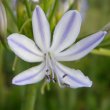
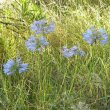
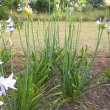
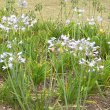
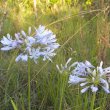
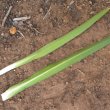


Discuss this plant
Share knowledge, ask a question or give an experience.